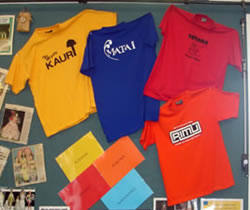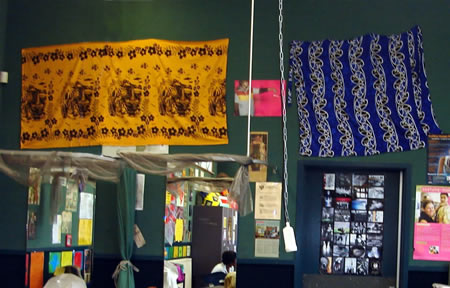Te Kotahitanga in a Technology classroom
 Class: Year 9-12
Class: Year 9-12
Teacher: Gael Harper
School: Whakatane High School
Category: Teaching strategy
Food and Textiles Technology teacher Gael Harper's classroom reflects Whakatane High School's commitment to Te Kotahitanga. Te Kotahitanga is an initiative that began in 2001 which aims to raise the educational achievement in Māori students. It emphasises the importance of educators creating learning contexts within their classrooms, and of their acknowledging the role that students' cultural identity plays in success.
Gael has made Te Kotahitanga a feature of her classroom and its rules for students – punctuality, bringing the correct gear, assisting others, completing lessons in class and homework – are posted on the wall on brightly coloured laminated card. The school Houses are named after native trees – Matai, Kauri, Rimu and Totara – and the House T-shirts in their bright colours hang on the wall.
"Aesthetics in the classroom are important,” she says. "If students work in a nice environment then they behave and work together. The classroom reinforces the school goals of respect, responsibility and achievement – I find that the students are respectful in my class.”
Gael uses decoration as a way of highlighting Māoritanga in the classroom and showing how it can be incorporated into Textiles Technology. She has made a big fabric map of New Zealand in Māori and a big 'tiki' cushion, which is kept in her room and helps inspire the Year 9s when they make their own cushions. Gael also teaches them appliqué – in the next Year 9 project each student will make a large letter of the Māori alphabet, to be joined as a frieze on the classroom wall.
Gael points out that it's not expensive or time-consuming to work with Te Kotahitanga – she buys items such as Māori calendars from bargain shops to add to that environment.
By drawing attention to role models and examples of success in the local community and nationally, Gael tries to challenge her students to think about what this involves and what they are capable of achieving. She draws attention to Māori designers and people working in careers she thinks her students could aspire to. She pins up relevant examples, such as the newspaper article about Otago University offering a degree in Textiles. "I talked to my Year 10s about it – some might think, 'Well, I could do that'. I cut out anything about technology in newspapers or magazines – I'm always on the lookout for new ideas and inspiration.”
Gael attends the annual Fibre and Fleece Fashion Show competition in Opotiki (40 minutes drive from the school), which features work in flax or natural fibres. This event attracts lots of publicity and she adds the photos and articles to her wall display in the hope that highlighting local activities and successes will encourage students to achieve - "I want them to see that they can climb a mountain in small steps”.
Gael says that her students feel at home in the classroom "as though they belong. The kids do absorb what's going on, and the T-shirts in particular really get them involved”. On the Year 8 information night, parents meet in her room, because the Technology teachers think it's such a good promotion of the department.
In the food workroom, which she uses for practical lessons, Gael has labels (produced by HETTANZ) listing things in Māori/English. She writes a Māori proverb (whakatoke) on the board each week, and is always on the lookout for proverbs or reflections for students to contemplate.
Gael incorporates a multi-cultural approach along with Te Kotahitanga, in recognition of other cultures represented in the school. She has hung an Indian sari and Pacific Island fabrics on the walls, and promotes inclusiveness with activities such as a visiting speaker who talked about 'Where in the world is your classroom?' and discussed with students their place in New Zealand and in a multi-cultural society.


